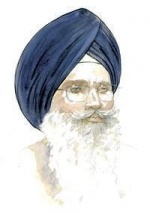Template:AOW6: Difference between revisions
Hari singh (talk | contribs) mNo edit summary |
Hari singh (talk | contribs) mNo edit summary |
||
| Line 1: | Line 1: | ||
[[Image:Turban sikh.jpg|thumb|150px|right|Sikh man with a Turban and uncut beard]] | [[Image:Turban sikh.jpg|thumb|150px|right|Sikh man with a Turban and uncut beard]] | ||
'''[[Turban]]''' is closely associated with [[Sikhism]]. Sikhism is the only religion in the world in which wearing a | '''[[Turban]]''' is closely associated with [[Sikhism]]. Sikhism is the only religion in the world in which wearing a turban is mandatory. Vast majority of people who wear turbans in the Western countries are [[Sikh]]s. The Sikh ''pagdi'' (ਪਗੜੀ) is also called ''dastaar'' (ਦਸਤਾਰ), which is a more respectful word in [[Punjabi]] for the turban. | ||
Sikh's are famous for their distinctive turbans. The turban represents respectability, and is a sign of nobility. [[Guru Gobind Singh]] gave all of his [[Sikh]]s turbans to recognize the the high moral status that the [[Khalsa]] has to adhere to. A turbaned sikh stands out from the crowd and is easily recognizable. The '''dastaar''', as the Sikh turban is commonly known as is an article of faith. This was made mandatory by the founders of [[Khalsa]] and all baptised [[Sikh]]s are required to wear a '''Dastaar'''. It is not to be regarded as mere cultural paraphernalia. '''[[Turban| Continued.....]]''' | |||
' | |||
Revision as of 04:31, 3 June 2006
Turban is closely associated with Sikhism. Sikhism is the only religion in the world in which wearing a turban is mandatory. Vast majority of people who wear turbans in the Western countries are Sikhs. The Sikh pagdi (ਪਗੜੀ) is also called dastaar (ਦਸਤਾਰ), which is a more respectful word in Punjabi for the turban.
Sikh's are famous for their distinctive turbans. The turban represents respectability, and is a sign of nobility. Guru Gobind Singh gave all of his Sikhs turbans to recognize the the high moral status that the Khalsa has to adhere to. A turbaned sikh stands out from the crowd and is easily recognizable. The dastaar, as the Sikh turban is commonly known as is an article of faith. This was made mandatory by the founders of Khalsa and all baptised Sikhs are required to wear a Dastaar. It is not to be regarded as mere cultural paraphernalia. Continued.....

